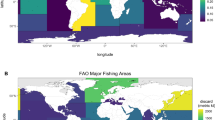Abstract
Over 75% of the world marine fisheries catch (over 80 million tonnes per year) is sold on international markets, in contrast to other food commodities (such as rice)1,2. At present, only one institution, the Food and Agriculture Organization of the United Nations (FAO) maintains global fisheries statistics. As an intergovernmental organization, however, FAO must generally rely on the statistics provided by member countries, even if it is doubtful that these correspond to reality. Here we show that misreporting by countries with large fisheries, combined with the large and widely fluctuating catch of species such as the Peruvian anchoveta, can cause globally spurious trends. Such trends influence unwise investment decisions by firms in the fishing sector and by banks, and prevent the effective management of international fisheries.
This is a preview of subscription content, access via your institution
Access options
Subscribe to this journal
Receive 51 print issues and online access
$199.00 per year
only $3.90 per issue
Buy this article
- Purchase on Springer Link
- Instant access to full article PDF
Prices may be subject to local taxes which are calculated during checkout


Similar content being viewed by others
References
Food and Agriculture Organization. Fisheries Trade Flow (1995–1997) 1–330 (Fisheries Information, Data and Statistics Unit, FAO Fisheries Circular No. 961, Rome, 2000).
IRRI. in Rice Almanac (ed. Maclean, J.) 2nd edn, 31–37 (International Rice Research Institute, Los Baños, Philippines, 1997).
Food and Agriculture Organization. FISHSTAT Plus. Universal software for fishery statistical time series. Version 2.3. (Fisheries Department, Fishery Information, Data and Statistics Unit, Rome, 2000).
Muck, P. in The Peruvian Upwelling Ecosystem: Dynamics and Interactions (eds Pauly D., Muck, P., Mendo, J. & Tsukayama, I.) 386–403 (International Centre for Living Aquatic Resource Management, Makati, Philippines, 1989).
Alverson, D. L., Freeberg, M., Pope, J. & Murawski, S. A Global Assessment of Fisheries By-catch and Discards: A Summary Overview. 1–233 (FAO Fisheries Technical Paper 339, Rome, 1994).
Pauly, D. One hundred million tonnes of fish, and fisheries research. Fish. Res. 25, 25–38 (1996).
Tang, Q. in Biomass Yields and Geography of Large Marine Ecosystems (eds Sherman, K. & Alexander, L. M.) 7–35 (AAAS Selected Symp. 111, Westview, Boulder, 1989).
Huang, B. & Walters, C. J. Cohort analysis and population dynamics of large yellow croaker in the China Sea. N. Am. J. Fish. Man. 3, 295–305 (1983).
Chen, W. Marine Resources: Their Status of Exploitation and Management in the People's Republic of China. 1–60 (FAO Fisheries Circular No. 950, Rome, 1999).
Pang, L. & Pauly, D. in The Marine Fisheries of China: Development and Reported Catches (authors Watson, R., Pang, L. & Pauly, D.) 1–27 (Fisheries Centre Research Report 9(2), Univ. British Colombia, Vancouver, 2001); also at http://fisheries.ubc.ca/Reports/china.pdf.
Kwong, L. The Political Economy of Corruption in China 1–75 (M. E. Sharpe, Armonk, New York, 1997).
Botsford, L. W., Castilla, J. C. & Peterson, C. H. The management of fisheries and marine ecosystems. Science 277, 509–515 (1997).
Pauly, D., Christensen, V., Dalsgaard, J., Froese, R. & Torres, F. C. Jr Fishing down marine food webs. Science 279, 860–863 (1998).
Naylor, R. L. et al. Effect of aquaculture on world fish supplies. Nature 405, 1017–1024 (2000).
Watson, R., Gelchu, A. & Pauly, D. in Fisheries Impacts on North Atlantic Ecosystems: Catch, Effort, and National/Regional Data Sets. (eds Zeller, D., Watson, R. & Pauly, D.) (Fisheries Centre Research Report, Univ. British Colombia, Vancouver, in the press).
Longhurst, A. Ecological Geography of the Sea 77–85 (Academic, San Diego, 1998).
Veridian Information Solutions 2000. Global Maritime Boundaries Database CD. (Veridian, Fairfax, Virginia, 2000).
Food and Agriculture Organization. Fisheries Agreements Register (FARISIS). 1–4 (Committee on Fisheries, 23rd session, Rome, 1999; COFI/pp/Inf.9E, 1998).
Froese, R. & Pauly, D. (eds) FishBase 2000. Concepts, design and data sources. ((International Centre for Living Aquatic Resource Management, Los Baños, Philippines, 2000); 4CD-ROMs; updates on http://www.fishbase.org.
S-Plus Guide to Statistics. Vol. 1 (Data Analysis Product Division, MathSoft, Seattle, 2000).
Acknowledgements
We thank V. Christensen for the upwelling index, and A. Gelchu for the species distribution shape files used here. We also thank our colleagues in the ‘Sea Around Us’ Project. This work was supported by the Pew Charitable Trusts through the ‘Sea Around Us’ Project, Fisheries Centre, University of British Columbia. D.P. also acknowledges support from the National Science and Engineering Council of Canada.
Author information
Authors and Affiliations
Corresponding author
Rights and permissions
About this article
Cite this article
Watson, R., Pauly, D. Systematic distortions in world fisheries catch trends. Nature 414, 534–536 (2001). https://doi.org/10.1038/35107050
Received:
Accepted:
Issue Date:
DOI: https://doi.org/10.1038/35107050
This article is cited by
-
Identification of potential breeding ground of flathead grey mullet, Mugil cephalus (Linnaeus, 1758), along the Mumbai coast, India, for ecological monitoring and conservation strategies
Environmental Monitoring and Assessment (2023)
-
Species traits determined different responses to “zero-growth” policy in China’s marine fisheries
Scientific Reports (2022)
-
Over 90 endangered fish and invertebrates are caught in industrial fisheries
Nature Communications (2020)
-
Taking stock: a Large Marine Ecosystem perspective of socio-economic and ecological trends in East China Sea fisheries
Reviews in Fish Biology and Fisheries (2020)
-
Measuring Willingness to Pay for Environmental Attributes in Seafood
Environmental and Resource Economics (2019)
Comments
By submitting a comment you agree to abide by our Terms and Community Guidelines. If you find something abusive or that does not comply with our terms or guidelines please flag it as inappropriate.



